Preparation of BN Nanoparticle with High Sintering Activity and Its Formation Mechanism
Abstract
:1. Introduction
2. Results and Discussion
2.1. Characterization of Precursors
2.2. Characterization of the h-BN Products
2.3. Formation Mechanism of h-BN
2.4. Specific Surface Area Analysis of h-BN
3. Experimental Section
3.1. Preparation of h-BN Nanoparticles
3.2. Characterization
4. Conclusions
- (1)
- The morphology and structure of h-BN products are significantly affected by the treatment temperature of precursors. When the sintering temperature is 1300 °C, the morphology gradually transforms from flake-like to sphere structure with the increase in treatment temperature.
- (2)
- The crystallinity and dispersibility will be greatly improved with the sintering temperature increasing. The optimal condition for obtaining high-quality spherical h-BN with size of 30–50 nm is the pretreatment temperature of 250 °C and sintering temperature of 1300 °C.
- (3)
- The h-BN obtained using 250 °C precursors shows a higher specific surface area (61.1 m2 g−1) than that of 145 °C (27.9 m2 g−1) and 85 °C (36.5 m2 g−1), indicating that it will present higher sintering activity.
- (4)
- The reaction pathway and formation mechanism of h-BN have been revealed by DFT calculations. TS search shows that the five stationary states and five transition states exist in the reaction pathway. Additionally, boric acid and urea are easily combined to form intermediates, and the calculated barrier can be overcome at high temperatures to form a ring h-BN structure.
Author Contributions
Funding
Institutional Review Board Statement
Informed Consent Statement
Data Availability Statement
Conflicts of Interest
References
- Wang, Q.; Wang, X.; Wang, Y.; Bando, Y.; Golberg, D. Functionalized hexagonal boron nitride nanomaterials: Emerging properties and applications. Chem. Soc. Rev. 2016, 45, 3989–4012. [Google Scholar] [CrossRef] [PubMed]
- Roy, S.; Zhang, X.; Puthirath, A.B. Structure, properties and applications of two-dimensional hexagonal boron nitride. Adv. Mater. 2021, 33, 2101589. [Google Scholar] [CrossRef]
- Jiang, X.F.; Weng, Q.; Wang, X.B.; Li, X.; Zhang, J.; Golberg, Y.; Bando, Y. Recent progress on fabrications and applications of boron nitride nanomaterials: A review. J. Mater. Sci. Technol. 2015, 31, 589–598. [Google Scholar] [CrossRef]
- Lian, G.; Zhang, X.; Zhu, L.; Tan, M.; Cui, D.; Wang, Q. A facile solid state reaction route towards nearly monodisperse hexagonal boron nitride nanoparticles. J. Mater. Chem. 2010, 20, 3736–3742. [Google Scholar] [CrossRef]
- Lian, G.; Zhang, X.; Si, H.; Wang, J.; Cui, D.; Wang, Q. Boron nitride ultrathin fibrous nanonets: One-step synthesis and applications for ultrafast adsorption for water treatment and selective filtration of nanoparticles. ACS Appl. Mater. Inter. 2013, 5, 12773–12778. [Google Scholar] [CrossRef] [PubMed]
- Zhang, X.; Lian, G.; Zhang, S.; Cui, D.; Wang, Q. Boron nitride nanocarpets: Controllable synthesis and their adsorption performance to organic pollutants. CrystEngComm 2012, 14, 4670–4676. [Google Scholar] [CrossRef]
- Lian, G.; Zhang, X.; Zhang, S.; Liu, D.; Cui, D.; Wang, Q. Controlled fabrication of ultrathin-shell BN hollow spheres with excellent performance in hydrogen storage and wastewater treatment. Energy Environ. Sci. 2012, 5, 7072–7080. [Google Scholar] [CrossRef]
- Xue, Y.; Dai, P.; Jiang, X.; Wang, X.; Zhang, C.; Tang, D.; Weng, Q.; Wang, X.; Pakdel, A.; Tang, C.; et al. Template-free synthesis of boron nitride foam-like porous monoliths and their high-end applications in water purification. J. Mater. Chem. 2016, 4, 1469–1478. [Google Scholar] [CrossRef]
- Li, Q.; Yang, T.; Yang, Q.; Wang, F.; Chou, K.C.; Hou, X. Porous hexagonal boron nitride whiskers fabricated at low temperature for effective removal of organic pollutants from water. Ceram. Int. 2016, 42, 8754–8762. [Google Scholar] [CrossRef]
- Men, J.; Li, B.; Li, J.; Li, G.; Chen, J.; Hou, X. Amorphous liquid phase induced synthesis of boron nitride nanospheres for improving sintering property of h-BN/ZrO2 composites. Ceram. Int. 2020, 46, 8031–8038. [Google Scholar] [CrossRef]
- Duan, X.; Jia, D.; Wang, Z.; Cai, D.; Tian, Z.; Yang, Z.; He, P.; Wang, S.; Zhou, Y. Influence of hot-press sintering parameters on microstructures and mechanical properties of h-BN ceramics. J. Alloys Compd. 2016, 684, 474–480. [Google Scholar] [CrossRef]
- Zhang, Z.; Duan, X.; Qiu, B.; Chen, L.; Zhang, P.; Cai, D.; He, P.; Zhang, H.; Wei, Z.; Yang, Z.; et al. Microstructure evolution and grain growth mechanisms of h-BN ceramics during hot-pressing. J. Eur. Ceram. Soc. 2020, 40, 2268–2278. [Google Scholar] [CrossRef]
- Cai, D.; Yang, Z.; Duan, X.; Liang, B.; Li, Q.; Jia, D.; Zhou, Y. A novel BN–MAS system composite ceramics with greatly improved mechanical properties prepared by low temperature hot-pressing. Mater. Sci. Eng. A. 2015, 633, 194–199. [Google Scholar] [CrossRef]
- Liao, N.; Qin, B.; Nath, M.; Li, Y.; Sang, S. Effects of nano ZrO2 content on the comprehensive properties of BN-SiC composites. J. Alloys Compd. 2020, 813, 152180. [Google Scholar] [CrossRef]
- Zhai, F.; Li, S.; Sun, J.; Yi, Z. Microstructure, mechanical properties and thermal shock behavior of h-BN-SiC ceramic composites prepared by spark plasma sintering. Ceram. Int. 2017, 43, 2413–2417. [Google Scholar] [CrossRef]
- Li, Y.; Yin, J.; Wu, H.; Deng, H.; Chen, J.; Yan, Y.; Liu, X.; Huang, Z.; Jiang, D. Enhanced electrical resistivity in SiC–BN composites with highly-active BN nanoparticles synthesized via chemical route. J. Eur. Ceram. Soc. 2015, 35, 1647–1652. [Google Scholar] [CrossRef]
- Zhang, Z.; Duan, X.; Qiu, B.; Chen, L.; Cai, D.; He, P.; Yang, Z.; Jia, D.; Zhou, Y. Improvement of grain size and crystallization degree of LPSed h-BN composite ceramics by amorphization/nanocrystallization of raw h-BN powders. J. Alloys Compd. 2021, 852, 156765. [Google Scholar] [CrossRef]
- Li, Y.; Ge, B.; Wu, Z.; Xiao, G.; Shi, Z.; Jin, Z. Effects of h-BN on mechanical properties of reaction bonded β-SiAlON/h-BN composites. J. Alloys Compd. 2017, 703, 180–187. [Google Scholar] [CrossRef]
- Liu, J.; Zhang, T.; Wang, Z.; Dawson, G.; Chen, W. Simple pyrolysis of urea into graphitic carbon nitride with recyclable adsorption and photocatalytic activity. J. Mater. Chem. 2011, 38, 14398–14401. [Google Scholar] [CrossRef]
- Chen, J.P.; Isa, K. Thermal decomposition of urea and urea derivatives by simultaneous TG/(DTA)/MS. J. Mass Spectrom. Soc. Jan. 1998, 46, 299–303. [Google Scholar] [CrossRef]
- Schaber, P.M. Thermal decomposition (pyrolysis) of urea in an open reaction vessel. Thermochim. Acta 2004, 424, 131–142. [Google Scholar] [CrossRef]
- Parsons, J.L. Vibrational spectra of orthorhombic metaboric acid. J. Chem. Phys. 1960, 33, 1860–1866. [Google Scholar] [CrossRef]
- Hou, X.; Yu, Z.; Chou, K.C. Facile synthesis of hexagonal boron nitride fibers with uniform morphology. Ceram. Int. 2013, 39, 6427–6431. [Google Scholar] [CrossRef]
- Song, Y.; Kim, S.; Lim, M.; Cho, H.B.; Choa, Y.H. Synthesis of size-controlled and in-situ OH functionalized hexagonal boron nitride powder by hetero-phase reaction. Appl. Surf. Sci. 2021, 558, 149885. [Google Scholar] [CrossRef]
- Fang, Y.; Xue, Y.; Song, Q.; Lin, J.; Liu, Z.; Li, L.; Wang, C.; Huang, Y.; Tang, C. Rapid synthesis and characterization of long afterglow BCNO phosphors by self-propagating combustion method. Opt. Mater. 2018, 85, 451–455. [Google Scholar] [CrossRef]
- Chu, Z.; Kang, Y.; Jiang, Z.; Li, G.; Hu, T.; Wang, J.; Zhou, Z.; Li, Y.; Wang, X. Graphene oxide based BCNO hybrid nanostructures: Tunable band gaps for full colour white emission. RSC Adv. 2014, 4, 26855–26860. [Google Scholar] [CrossRef]
- Guo, J.; Duan, Y.; Wu, T. Atomically dispersed cerium sites in carbon-doped boron nitride for photo driven CO2 reduction: Local polarization and mechanism insight. Appl. Catal. B. 2023, 324, 122235. [Google Scholar] [CrossRef]
- Zhang, N.; Zhang, T.; Kan, H.; Wang, X.; Long, H.; Zhou, Y. The Research of the synthesis mechanism and synthesis process of high crystallinity globular h-BN. J. Inorg. Organomet. Polym. Mater. 2015, 25, 1495–1501. [Google Scholar] [CrossRef]
- Biswas, A.; Kapse, S.; Thapa, R.; Dey, R.S. Oxygen functionalization-induced charging effect on boron active sites for high-yield electrocatalytic NH3 production. Nano-Micro Lett. 2022, 14, 214. [Google Scholar] [CrossRef]
- Gudz, K.Y.; Matveev, A.T.; Permyakova, E.S.; Bondarev, A.V.; Slukin, P.V.; Ignatov, S.G.; Shtansky, D.V. Nanostructured hexagonal BN coating-supported silver and iron oxide nanoparticles and related bactericidal and fungicidal activities. Appl. Surf. Sci. 2022, 603, 154418. [Google Scholar] [CrossRef]
- Li, Q.; Zheng, Y.; Hou, X.; Yang, T.; Liang, T.; Zheng, J. A wide range photoluminescence intensity-based temperature sensor developed with BN quantum dots and the photoluminescence mechanism. Sens. Actuat. B Chem. 2020, 304, 127353. [Google Scholar] [CrossRef]
- Xi, G.; Xiong, K.; Zhao, Q.; Zhang, R.; Qian, Y. Nucleation-dissolution-recrystallization: A new growth mechanism fort–selenium nanotubes. Cryst. Growth Des. 2006, 6, 577–582. [Google Scholar] [CrossRef]
- Xu, R.; Zeng, H.C. Dimensional control of cobalt-hydroxide-carbonate nanorods and their thermal conversion to one-dimensional arrays of Co3O4 nanoparticles. J. Phys. Chem. B 2003, 107, 12643–12649. [Google Scholar] [CrossRef]
- Cheng, T.; Bets, K.V.; Yakobson, B.I. Hydrogen-driven boron nitride phase differentiation during the epitaxial nucleation on the diamond (001) surface. ChemRxiv 2024. [Google Scholar] [CrossRef]
- Xu, Y.; Li, T.; Xu, W.; Li, C.; E, S.; Wang, L.; Long, X.; Bai, Y.; Xu, L.; Yao, Y. Scalable production of high-quality boron nitride nanosheets via a recyclable salt-templating method. Green Chem. 2019, 24, 6746–6753. [Google Scholar] [CrossRef]
- Uene, N.; Mabuchi, T.; Zaitsu, M.; Jin, Y.; Yasuhara, S.; Tokumasu, T. Growth mechanism study of boron nitride atomic layer deposition by experiment and density functional theory. Comp. Mater. Sci. 2023, 217, 111919. [Google Scholar] [CrossRef]
- Barick, P.; Saha, B.P. Effect of boron nitride addition on densification, microstructure, mechanical, thermal, and dielectric properties of β-SiAlON ceramic. J. Mater. Eng. Perform. 2021, 30, 3603–3611. [Google Scholar] [CrossRef]
- Niu, B.; Cai, D.; Yang, Z.; Duan, X.; Sun, Y.; Li, H.; Duan, W.; Jia, D.; Zhou, Y. Anisotropies in structure and properties of hot-press sintered h-BN-MAS composite ceramics: Effects of raw h-BN particle size. J. Eur. Ceram. Soc. 2019, 39, 539–546. [Google Scholar] [CrossRef]
- Han, W.; Ma, Z.; Liu, S.; Ge, C.; Wang, L.; Zhang, X. Highly-dispersible boron nitride nanoparticles by spray drying and pyrolysis. Ceram. Int. 2017, 43, 10192–10200. [Google Scholar] [CrossRef]
- Kiatphuengporn, S.; Chareonpanich, M.; Limtrakul, J. Effect of unimodal and bimodal MCM-41 mesoporous silica supports on activity of Fe–Cu catalysts for CO2 hydrogenation. Chem. Eng. J. 2014, 240, 527–533. [Google Scholar] [CrossRef]
- Chen, D.; Cao, L.; Huang, F.; Paolo, I.; Cheng, Y.B.; Rachel, C. Synthesis of monodisperse mesoporous titania beads with controllable diameter, high surface areas, and variable pore diameters (14–23 nm). J. Am. Chem. Soc. 2010, 132, 4438–4444. [Google Scholar] [CrossRef] [PubMed]
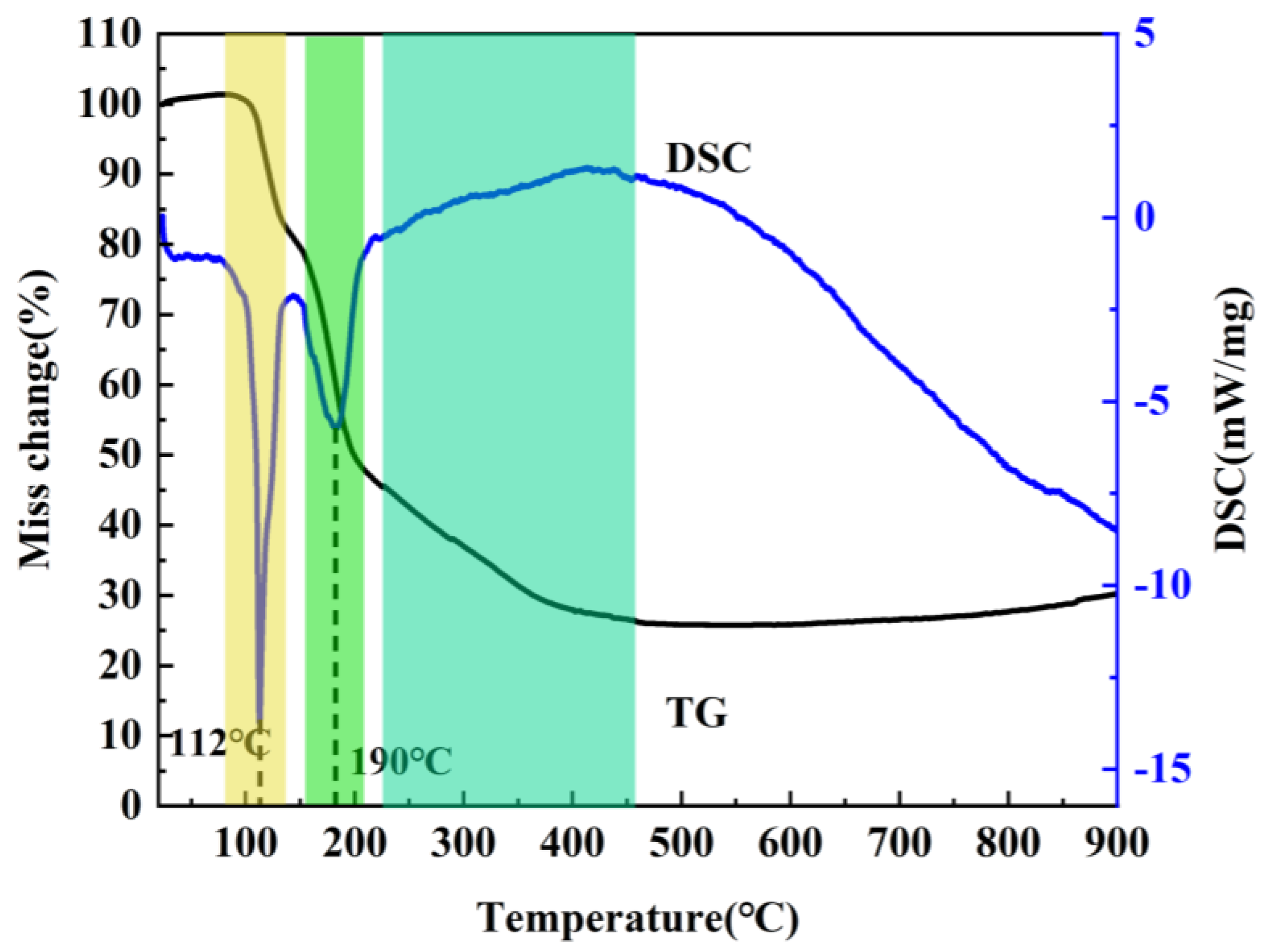

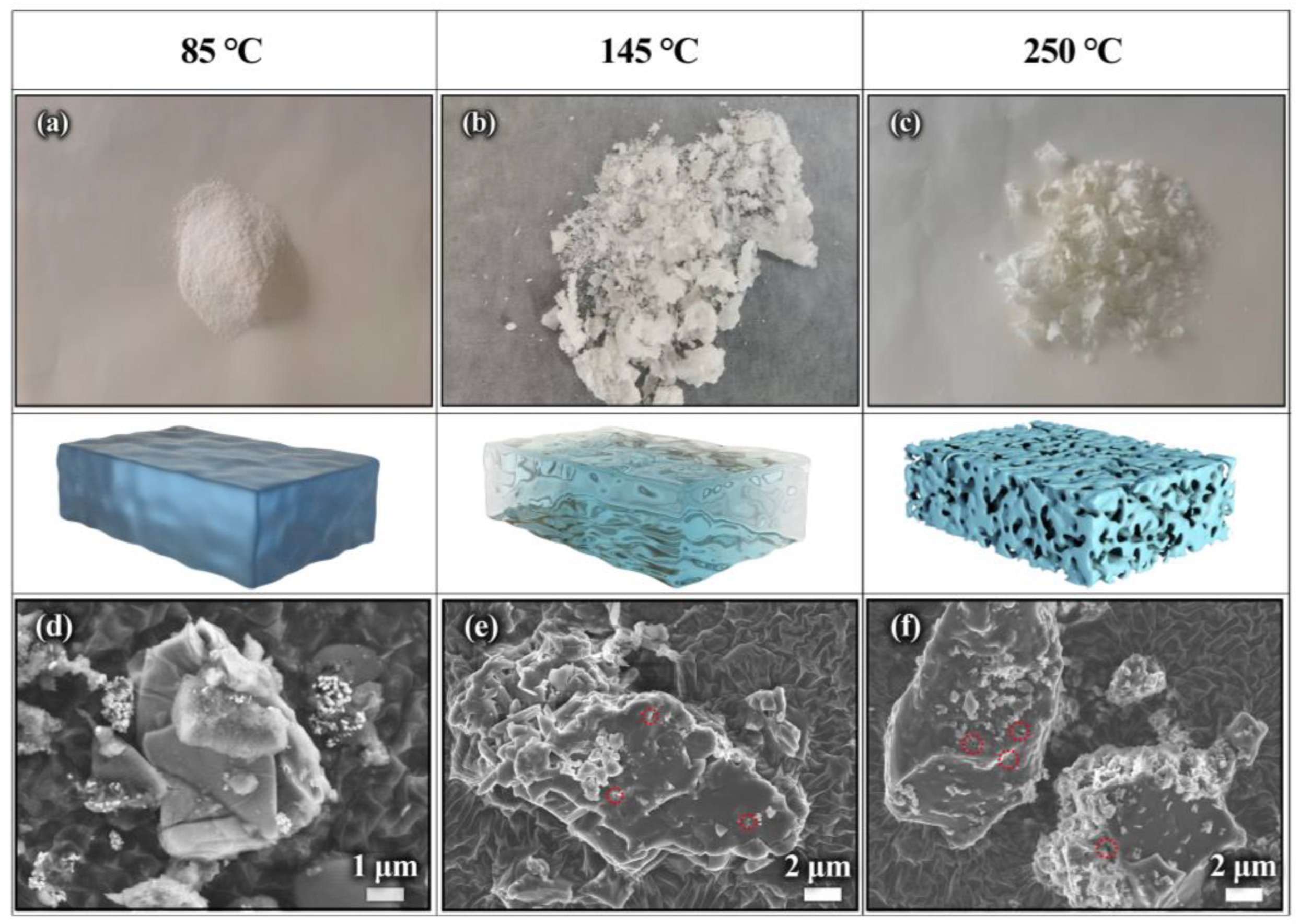
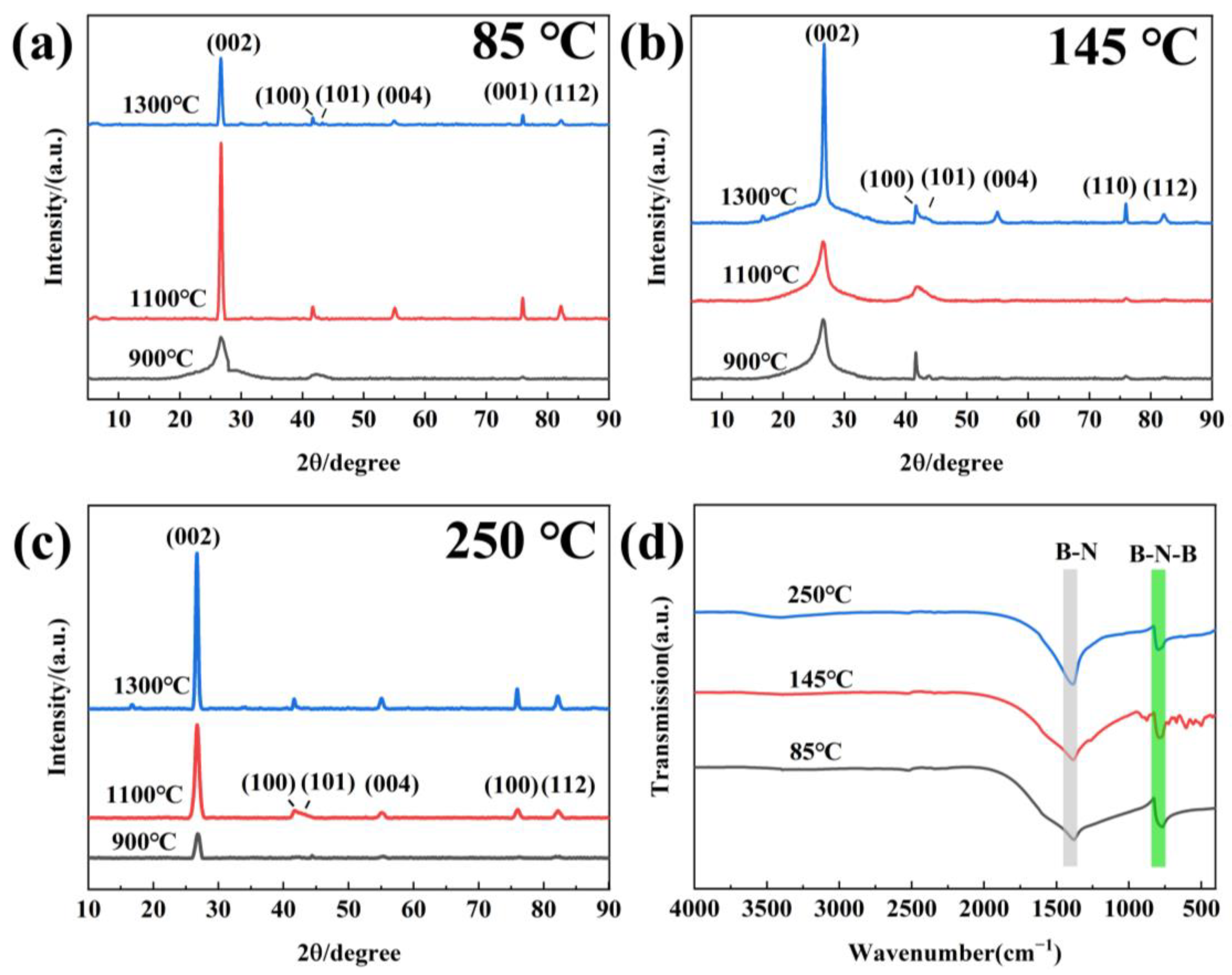

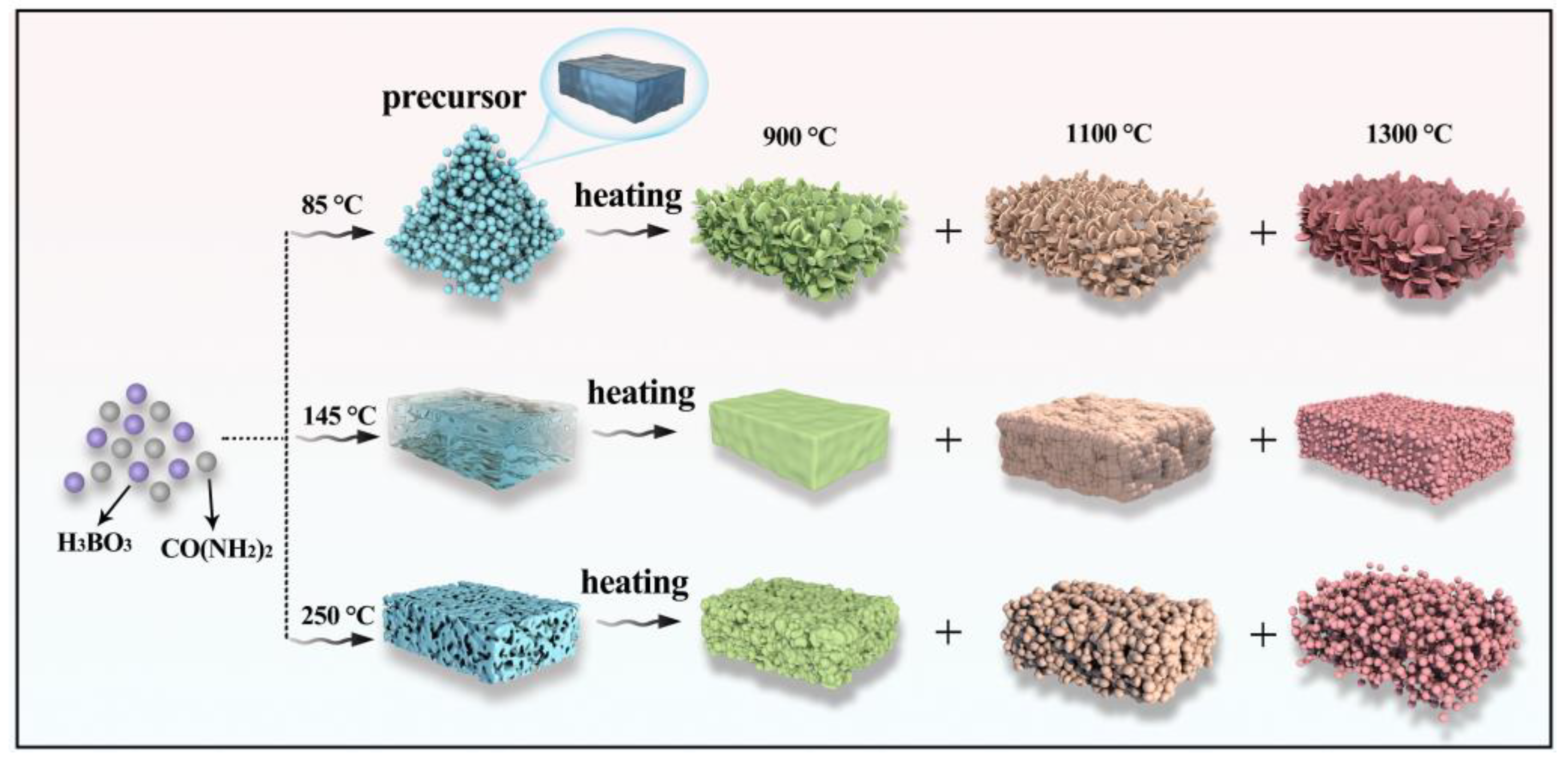
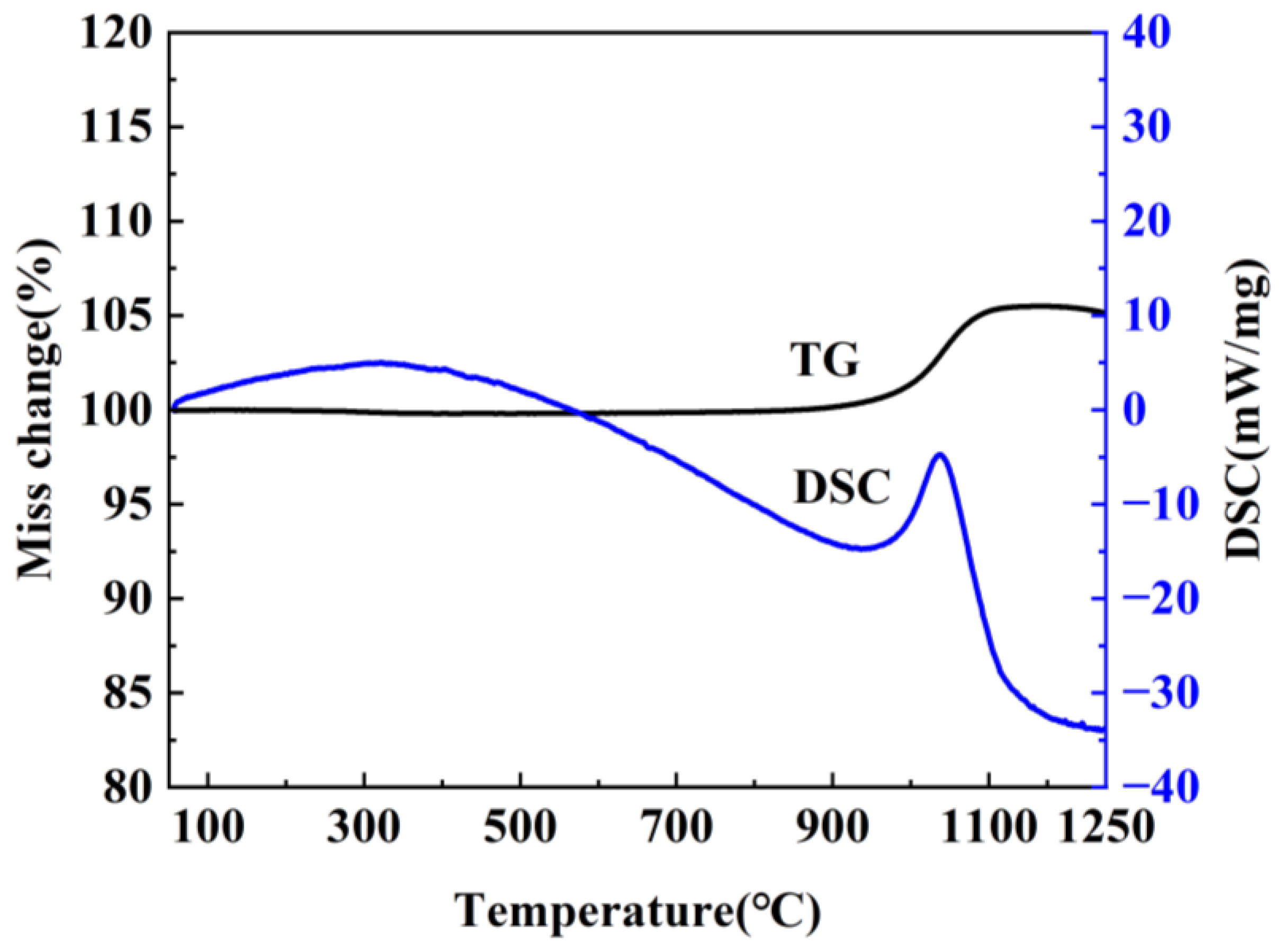

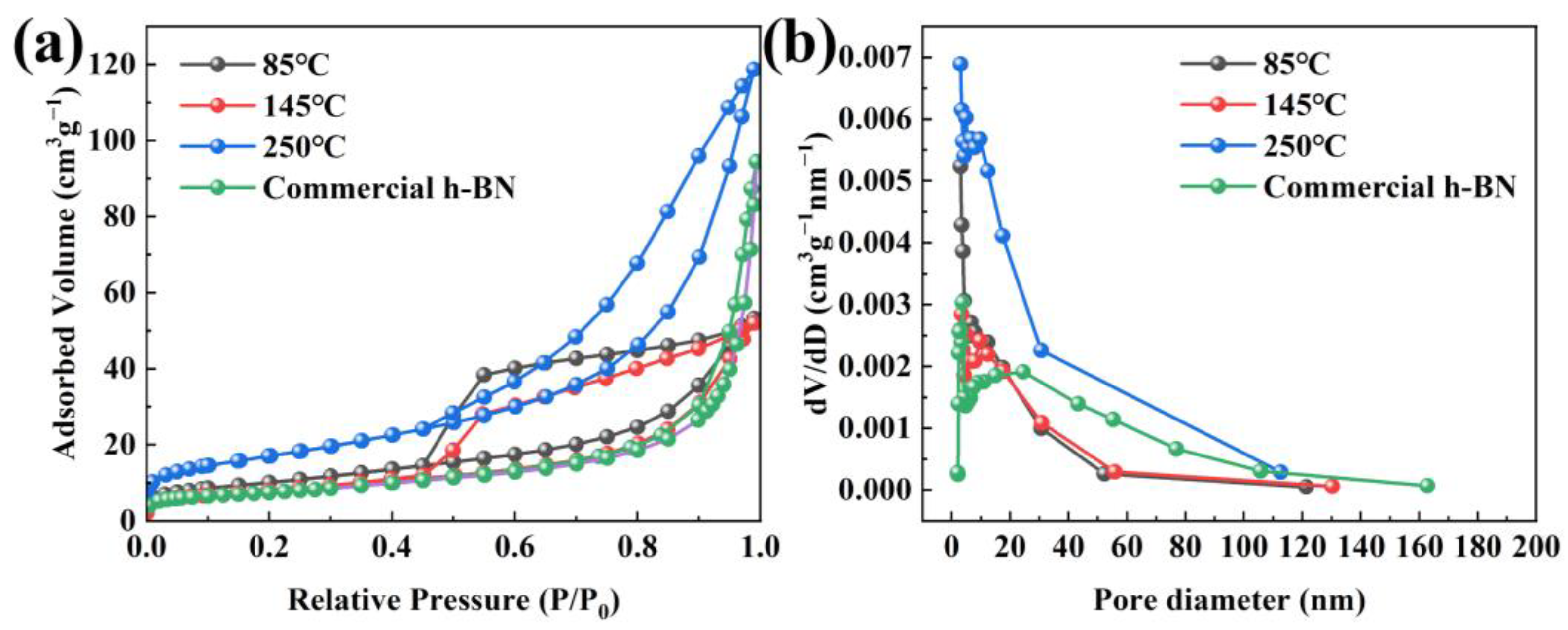

Disclaimer/Publisher’s Note: The statements, opinions and data contained in all publications are solely those of the individual author(s) and contributor(s) and not of MDPI and/or the editor(s). MDPI and/or the editor(s) disclaim responsibility for any injury to people or property resulting from any ideas, methods, instructions or products referred to in the content. |
© 2024 by the authors. Licensee MDPI, Basel, Switzerland. This article is an open access article distributed under the terms and conditions of the Creative Commons Attribution (CC BY) license (https://creativecommons.org/licenses/by/4.0/).
Share and Cite
Li, Q.; Zhang, K.; Che, X.; Gao, T.; Wang, S.; Ni, G. Preparation of BN Nanoparticle with High Sintering Activity and Its Formation Mechanism. Molecules 2024, 29, 3458. https://doi.org/10.3390/molecules29153458
Li Q, Zhang K, Che X, Gao T, Wang S, Ni G. Preparation of BN Nanoparticle with High Sintering Activity and Its Formation Mechanism. Molecules. 2024; 29(15):3458. https://doi.org/10.3390/molecules29153458
Chicago/Turabian StyleLi, Qun, Kuo Zhang, Xiangming Che, Tengchao Gao, Shuhuan Wang, and Guolong Ni. 2024. "Preparation of BN Nanoparticle with High Sintering Activity and Its Formation Mechanism" Molecules 29, no. 15: 3458. https://doi.org/10.3390/molecules29153458




